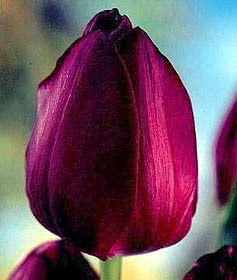Single EarlyAs the name suggests, this tulip is the first one to bloom. Usually one flower per stem and the flower is in the shape of a cup.
Flowering time:early spring Plant height:8 - 20" (20 - 50 cm); average: 10 - 18" (25 - 46 cm) Minimum planting depth:6" (15 cm) Hardiness zones:suitable for zones 3 - 8



Double Early
This type of tulip has more petals than the normal tulip and blooms nicely. The stems are fairly short but very strong and sturdy, and the blooms are very long lasting. These are excellent flowers for containers.
Flowering time:Early spring.
Plant height:8 - 16" (20 - 40 cm); average: 10 - 12" (25 - 30 cm)
Hardiness zones:suitable for zones 3 - 7



Triumph Tulips
The triumph is a cross between the early flowering singles and late flowering singles.It also comes in a wide range of colours.
Flowering time:Mid-spring.
Plant height:8 - 26" (20 - 68 cm); average: 16 - 22" (40 - 56 cm)
Hardiness zones:suitable for zones 3 - 7


Darwin Hybrid
The Darwin Hybrid is one tallest type of tulips. With long stems and multi colours, it is suitable for hand-tied wedding bouquets.
Flowering time:mid to late spring
Plant height:12 - 34" (30 - 86 cm); average: 18 - 24" (46 - 60 cm
Hardiness zones:suitable for zones 3 - 7



Rembrandt TulipsVery famous type of tulip in the 1600's in Holland and is no more available. There are however tulips from other categories that resemble the original Rembrandt Tulips.We now know that these unusual markings were actually caused by a virus, which eventually caused damage to the tulip bulbs. Because of this, the original Rembrandt Tulips are no longer sold commercially. However, there are quite a few modern, virus-free, Rembrandt "look-alike" tulips available, Flowering time:-variable; depends on which tulip they mutated from Plant height:-variableMinimum planting depth:-6" (15 cm) Hardiness zones:suitable for zones 3 - 7 Orange Bowl
Orange Bowl Zomerschoon
Zomerschoon 
Mona Lisa
Parrot Tulips
The petals of the Parrot tulips are not straight. They are often curled or twisted. The size of the flower is also quite large.
Flowering time - mid spring or late spring
Plant height:12 - 28" (30 - 70 cm); average: 16" (40 cm
Minimum planting depth:6" (15 cm)
Hardiness zones:suitable for zones 4 - 7
Estella Rijnveld
 Fantasy
Fantasy

Blue Parrot
Double Late
The Double Late tulips blooms quite late in spring but lasts a long time.
The Double Late is absolutely beautiful. When blooms, the flower opens up quite big and they look like Peonies. It is perfect for a round wedding bouquet.
Flowering time:late spring
Plant height:12 - 24" (30 - 60 cm); average: 16" (40 cm)
Minimum planting depth:6" (15 cm)
Hardiness zones:suitable for zones 3 - 7
 Angelique
Angelique
 Renown Unique
Renown Unique
 Lilac Perfection
Lilac Perfection
Carnaval de Nice
Kaufmanniana
The flowers have pointed petals which open almost completely flat on sunny days.
Flowering time:early spring
Plant height:4 - 12" (10 - 30 cm); average: 6" (15 cm)
Minimum planting depth:4 - 5" (10 - 12 cm)
Hardiness zones:suitable for zones 3 - 8
 Concerto
Concerto
 Stresa
Stresa
 Quebec
Quebec
Fosteriana
The Fosteriana is special. The petals are pointy in nature. Also great for your tulip wedding bouquet.
Flowering time:- Early spring
Plant height:-10 - 20" (25 - 50 cm); average: 14" (36 cm)
Minimum planting depth:-6" (15 cm)
Hardiness zones:-suitable for zones 3 - 8
Exotic Emperor
Red Emperor
Golden Emperor
Griegii
The Griegii petals are pointy,too.
They come in bright colours and often a combination of two colours.
Flowering time:-early springPlant height:6 - 16" (15 - 40 cm); average: 10" (25 cm0
Minimum planting depth:6" (15 cm)
Hardiness zones:suitable for zones 3 - 7 Tsar Peter
Tsar Peter
 Red Riding Hood
Red Riding Hood >
 Turkish Delight
Turkish Delight
Wild Tulips
This type of tulips are practically short and ideal for garden planting.
They have many varieties.
Clusiana Lady Jane
Humilis Violacea


 Most herbaceous types are hardy from Zone 8 to Zone 2, with some exceptions.
Most herbaceous types are hardy from Zone 8 to Zone 2, with some exceptions.























 Angelique
Angelique
 Lilac Perfection
Lilac Perfection
 Stresa
Stresa